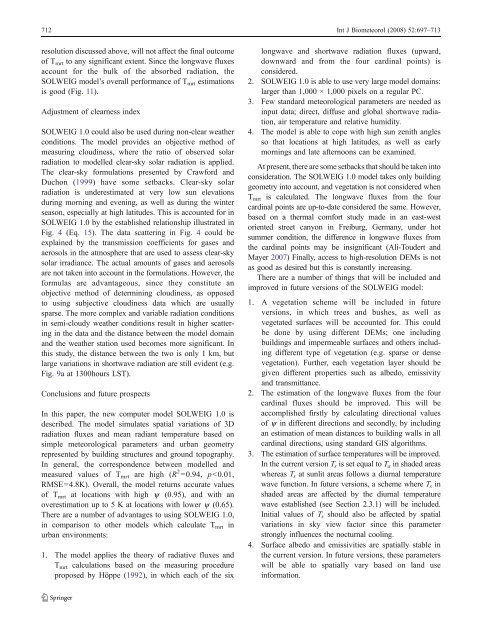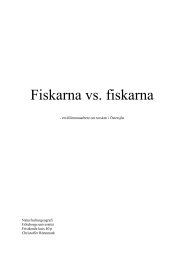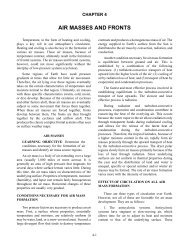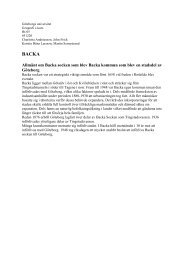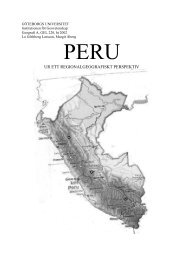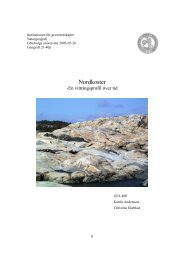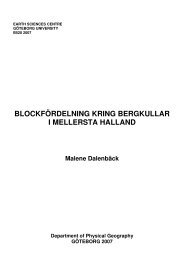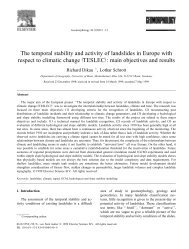SOLWEIG 1.0 – Modelling spatial variations of 3D radiant fluxes and ...
SOLWEIG 1.0 – Modelling spatial variations of 3D radiant fluxes and ...
SOLWEIG 1.0 – Modelling spatial variations of 3D radiant fluxes and ...
Create successful ePaper yourself
Turn your PDF publications into a flip-book with our unique Google optimized e-Paper software.
712 Int J Biometeorol (2008) 52:697<strong>–</strong>713<br />
resolution discussed above, will not affect the final outcome<br />
<strong>of</strong> T mrt to any significant extent. Since the longwave <strong>fluxes</strong><br />
account for the bulk <strong>of</strong> the absorbed radiation, the<br />
<strong>SOLWEIG</strong> model’s overall performance <strong>of</strong> Tmrt estimations<br />
is good (Fig. 11).<br />
Adjustment <strong>of</strong> clearness index<br />
<strong>SOLWEIG</strong> <strong>1.0</strong> could also be used during non-clear weather<br />
conditions. The model provides an objective method <strong>of</strong><br />
measuring cloudiness, where the ratio <strong>of</strong> observed solar<br />
radiation to modelled clear-sky solar radiation is applied.<br />
The clear-sky formulations presented by Crawford <strong>and</strong><br />
Duchon (1999) have some setbacks. Clear-sky solar<br />
radiation is underestimated at very low sun elevations<br />
during morning <strong>and</strong> evening, as well as during the winter<br />
season, especially at high latitudes. This is accounted for in<br />
<strong>SOLWEIG</strong> <strong>1.0</strong> by the established relationship illustrated in<br />
Fig. 4 (Eq. 15). The data scattering in Fig. 4 could be<br />
explained by the transmission coefficients for gases <strong>and</strong><br />
aerosols in the atmosphere that are used to assess clear-sky<br />
solar irradiance. The actual amounts <strong>of</strong> gases <strong>and</strong> aerosols<br />
are not taken into account in the formulations. However, the<br />
formulas are advantageous, since they constitute an<br />
objective method <strong>of</strong> determining cloudiness, as opposed<br />
to using subjective cloudiness data which are usually<br />
sparse. The more complex <strong>and</strong> variable radiation conditions<br />
in semi-cloudy weather conditions result in higher scattering<br />
in the data <strong>and</strong> the distance between the model domain<br />
<strong>and</strong> the weather station used becomes more significant. In<br />
this study, the distance between the two is only 1 km, but<br />
large <strong>variations</strong> in shortwave radiation are still evident (e.g.<br />
Fig. 9a at 1300hours LST).<br />
Conclusions <strong>and</strong> future prospects<br />
In this paper, the new computer model <strong>SOLWEIG</strong> <strong>1.0</strong> is<br />
described. The model simulates <strong>spatial</strong> <strong>variations</strong> <strong>of</strong> <strong>3D</strong><br />
radiation <strong>fluxes</strong> <strong>and</strong> mean <strong>radiant</strong> temperature based on<br />
simple meteorological parameters <strong>and</strong> urban geometry<br />
represented by building structures <strong>and</strong> ground topography.<br />
In general, the correspondence between modelled <strong>and</strong><br />
measured values <strong>of</strong> T mrt are high (R 2 =0.94, p


